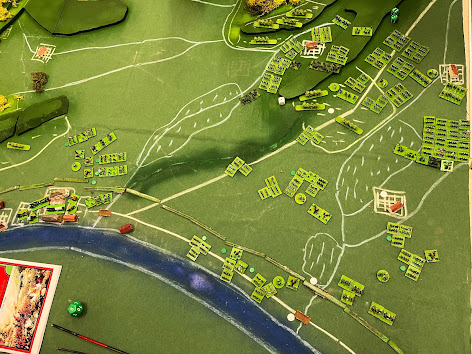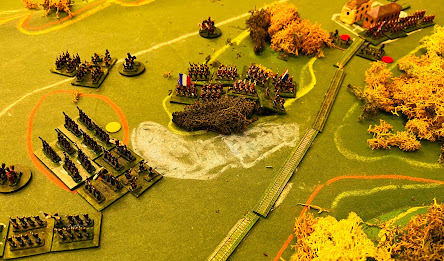I don't usually do "what-ifs". By that I mean, my staple fare is straight recreations of historical battles, in which forces have to start deployed broadly where they did historically and both sides are trying to achieve the objectives they were aiming for historically. The purpose of these (apart from providing a few hours' entertainment, obviously) is to let players explore various plans as different possible routes to victory - cracking tactical puzzles, if you like.
Occasionally, though, in the historical scenarios I write I might provide for some not too remote alternative possibility, such as the Russians at the Alma choosing to present a flank threat rather than a direct blocking position.
This week we explored a quite radical alternative. The scenario in question is the Second Battle of Vác (1849) from the Hungarian War of Independence, as found in the "Bloody Big Hungary '48 Battles!" scenario book. The standard historical scenario is an unusual and interesting one to start with, as it is an initial advance guard action followed by a fighting withdrawal. I did the straight refight back in January 2022 (in-depth report with lots of gorgeous photos here). The scenario provides an option that assumes the Hungarian C-in-C, Görgei, chooses the bold course of attempting to break through the Russian army that has intercepted him, rather than withdrawing to find another way around it as he did historically.
The following photos show how that went, with some reflections at the end.
'Der Donau ist blau.' The Hungarians start with an advance guard and two corps on table with a third due later. Here Leiningen's III Cps conducts its forced march along the Danube ...
... preceded by Nagysándor's I Cps, seen here marching through the town of Vác. Behind it is the railway embankment for Hungary's very own HS2. (At this time, the Hungarian rail network consisted of one line from Budapest southeast to Szolnok and another from Budapest north to Vác. The leg to Pressburg aka Bratislava was under construction.) Out of shot to the right is the Hungarian advance guard. This spent the first four turns driving back the Russian advance guard and making space for I Cps to push down the road to the south.

OMG that's a lot of Russians ... after the advance guard action, the scenario provides a Night Interval, a lull for everyone to have a rest after their forced marching and deploy for the next day's withdrawal or breakthrough attempt, as applicable. The Russians can deploy anywhere >6" from the Hungarians and south of the Csörög stream. Here you see about 50,000 men poised to crush the reckless Magyars, with a formidable gun line already deployed lower right. Only two of the units in shot are Hungarian: one in the bottom left corner and the other above that in the edge of the vineyard.

Plan view gives the full picture. The Hungarians are trying to push from left to bottom right. Victory depends on how wide a gap they can maintain at game end, as measured by how many of the four white counters they hold (the two bridges and the village of Sződ at lower right, and the vineyard above that). Russians are all in the upper right quarter. Hungarian I and III Cps are facing them, lower right. Pöltenberg's VII Cps has arrived around Vác (left centre) and will try to put pressure on the Russian right flank.
Most of I and III Cps immediately falls back to try to defend the line of the railway embankment, apart from one brigade that advances to occupy Sződ. VII Cps pushes forward on the Hungarian left.
A view from behind the railway embankment before the Russian hordes arrive there.
Turn 7 of 12. The solitary forward Hungarian brigade in Sződ has been demolished. Initial Russian assault on the Hungarian extreme right has been rebuffed, but worse is about to come.
Russian highwater mark - eight regiments assault the embankment.
Plan view, end of Turn 7 or 8. Russians continue to press forward bottom right but have been repulsed in the centre. Centre of pic, two Hungarian brigades and some hussars have crossed the embankment to attack the right flank of the massed Russian assault. Upper left, VII Cps and the Russians facing it find themselves in a stand-off.
Close-up of the Hungarian counterattack against the repulsed Russians. Their blurred images betray just how shaken those Russians are.
Unusually, we ended the game a couple of turns early because several of the guys had to leave a bit early. The rest of us could have finished it but we were happy to call it a draw. The Russian hordes had suffered enough infantry losses that they would have struggled to press another assault home, but they probably had enough guns to prevent the Hungarian counter-attack from carrying too far either.
The Hungarian army's historical withdrawal was seriously impeded by a column of thousands of refugees following it. Here we see the refugee column milling around and blocking movement through Vác. Even if the Hungarian army itself does break through the Russians, this tail of unfortunates is likely to be left at the mercy of Russian Cossacks and Caucasus Muslim cavalry.
Reflections:
An Illuminating 'What-If'. Görgei is widely regarded as Hungary's best general of the war. I think it fair to say that this what-if game confirmed the wisdom of his actual decision in this case. His historical withdrawal took his army into hilly country that aided rearguard actions to delay pursuit and made it difficult for the Russians to bring their superior numbers to bear; he was able to send his baggage and ammunition trains away first and give them a head start; the Russians were unsure about exactly where he was heading; his army escaped virtually intact (and then dodged behind and through the Russians, leading them on a merry dance for weeks). By contrast, our attempt to break through showed that it would have been pretty disastrous. Even if victorious, his army would have been mauled; it would then have had to march across open country, harassed by Russian light cavalry and Cossacks; it would probably have lost much of its supply train. No doubt I could have worked that out as the likely result beforehand, just as Görgei evidently did, but it was still highly instructive to see it play out on the table.
Shock and Awe: it's one thing to read (or indeed write) a scenario, and another to see the troops deployed. Once the Russian army appeared in full force after the Night Interval, we were all a bit gobsmacked - especially those of us on the Hungarian side tasked with fending it off. It goes to show that small figures can still make a big impression. 6mm is good for mass effect.
Quality vs Quantity: Görgei's army was a pretty well oiled machine at this stage, whereas the Russian one was a mighty but unsubtle steamroller. The Russians had also been ravaged by cholera, which killed more Russians than the Hungarians did in this war. The scenario therefore gives the Hungarians a quality advantage overall. By the time we stopped, this seemed to be on the way to compensating for Russian numerical superiority.
What is a 'What-If'? It's a bit of a stretch to claim this post as a genuine 'Reflection on Wargaming'. Really it's one battle report that prompted one particular thought that I've tried to expand on. I suppose I can expand on it a bit more by saying every game is a what-if to some degree (unless it is not a game at all but simply an exercise in pushing figures along courses utterly pre-determined by history, without any player choices or chance to deviate from that history). My typical historical recreations start the 'what-if' around the point at which historical opposing armies deployed for a historical battle, with their historical objectives and orders of battle, and explore how different plans might have worked out. The alternative version of Vác that I've reported here just changes the Hungarian C-in-C's aim - the mission, if you like - and explores a more radical strategic plan rather than grand tactical ones. A next step away from the historical event would be to have those same armies meet on a different battlefield, perhaps imagining a breakthrough attempt at a slightly different location; the step after that, to put historical opponents on some imaginary battlefield, tournament-style; beyond that, we get into competition-style games pitting ahistorical opponents against each other in battles that never happened, on terrain that didn't exist, in wars that were never fought. Which step of that progression we prefer depends on which 'what-if' question we want answered.
And finally: Thanks to Crispin for creating the custom battlemat, painting the armies and laying on the game.
For the full list of my (mostly rather more extensive and considered) 'Reflections on Wargaming' essays, see here.


















































